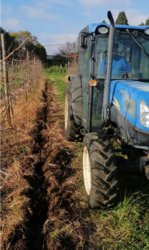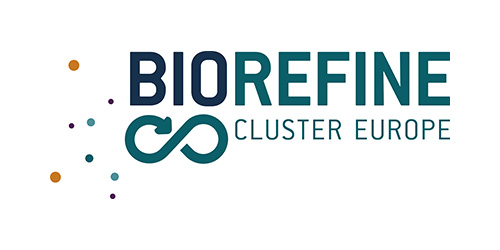Recovered Organic Materials and Composts for Precision Fertilization of Permanent Crops
26/01/2021

Within my doctoral research framed in the Nutri2Cycle project, we have two ongoing trials. One is in an apple orchard, cultivar ‘Gala’, located in our faculty, Instituto Superior de Agronomia, in Lisbon, and the other is in a vineyard of Vitis vinifera located in Montijo, Setúbal. The two trials benefit a classic Mediterranean climate.
Regarding the orchard, the main purpose was to evaluate the effects of the manure-based materials (MBM) application as a partial substitution (25%) of mineral fertilizers. Thus, we established a trial with four MBM treatments (cattle manure, poultry manure, cattle slurry, and acidified cattle slurry) and a control. The organic materials were applied in March at 50 cm depth (Fig. 1). Fruit production showed no significant difference between MBM treatments and the control, which was a good outcome for this first year of the trial since the organic materials did not harm crop production, as one would expect due to the slow nutrient release of the organic materials (slow decomposition rate). In concern to leaf analysis results, the control treatment had the lowest concentration of phosphorus (P), potassium (K), and Boron (B). This proves that the MBM was efficient at providing plant nutrients, even if that wasn’t reflected in the crop production.
About fruit quality, we registered significant differences between treatments in regards to flesh firmness, and insoluble solids content (SSC). Poultry manure showed apple production with higher SSC, and cattle manure with the lower SSC, which means that poultry manure produced the sweetest apples. Regarding the firmness of apples, it was acidified cattle manure treatment that produced the less firm apples. These traits are very subjective and difficult to compare, however, are very important for consumer acceptance, and so, must be taken into account.
In the vineyard trial, the goal was to implement site-specific management of vine fertilization, by delimitating homogenous zones in regards to soil nutrients content and other chemical properties. And so, we delimited three zones, Z1, Z2, and Z3 (Fig. 2), based on remote images of apparent electrical conductivity (ECap) and normalized difference vegetation index (NDVI), for collecting soil samples.
Preliminary results have shown that zones with high ECap, as in Z3, registered high EC (soil extract with H2O), as to no surprise, since both are used to determine the concentration of soluble inorganic salts in soil solution (soils salinity). At the same time, Z3 also had the highest base content (Na, Mg, Ca, and K), also responsible for soil salinity. Chemical analysis of soil samples, also showed that zones with higher NDVI levels, as in Z1 and Z2, had the highest nitrogen mineral (Nmin) concentration in soil, which was also an expectable outcome, since NDVI is an indicator of green healthy vegetation, and is often correlated to N content, usually the most relevant nutrient for green vegetation growth. Z3, on the other hand, has a low NDVI index and showed to have low Nmin content in the soil.
Hence, we concluded that using ECap and NDVI remote measurements, which are also more cost-effective and require less labor, are good predictors of soil salinity and consequently, soil base content, and also of soil Nmin content. Using said measurements, it was possible to delineate three distinct zones, with homogenous nutrient content in soil chemistry within each zone area and can facilitate soil sampling in the future, by reducing the number of soil samples necessary for soil characterization.


Catarina Esteves, PhD student
catarinaesteves1@campus.ul.pt


 This project has received funding from the European Union’s Horizon 2020
This project has received funding from the European Union’s Horizon 2020